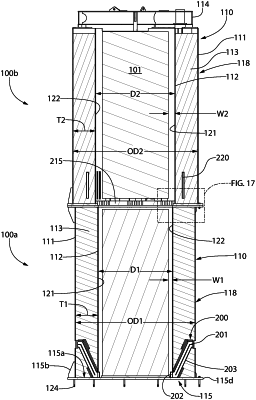| CPC G21F 5/10 (2013.01) [G21F 5/008 (2013.01); G21F 5/12 (2013.01)] | 24 Claims |

|
1. A passively ventilated nuclear waste storage system comprising:
a lower cask comprising:
a first top end and a first bottom end;
a first sidewall extending between the first top and first bottom ends, the first sidewall comprising a first outer shell and a first inner shell;
a first internal cavity defined by the first inner shell of the first sidewall and having a first diameter, the first internal cavity extending between the first top and first bottom ends along a first cavity axis and configured for holding a first nuclear waste canister;
at least one first air inlet duct configured to draw cooling air into a first bottom portion of the first internal cavity of the lower cask;
an upper cask comprising:
a second top end and a second bottom end;
a second sidewall extending between the second top and second bottom ends, the second sidewall comprising a second outer shell and a second inner shell;
a second internal cavity defined by the second inner shell of the second sidewall and having a second diameter, the second internal cavity extending between the second top and second bottom ends along a second cavity axis and configured for holding a second nuclear waste canister;
at least one outlet duct configured to allow heated air in a top portion of the second internal cavity to exit the second internal cavity of the upper cask; and
the upper cask stacked atop the lower cask in a vertically stacked arrangement so that a cask-to-cask interface is formed between the upper and lower casks;
wherein the first and second internal cavities are fluidly interconnected so that heated air in a top portion of the first internal cavity can flow into a second bottom portion of the second internal cavity;
wherein the second diameter of the second internal cavity of the upper cask is larger than the first diameter of the first internal cavity of the lower cask.
|